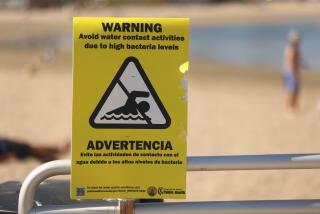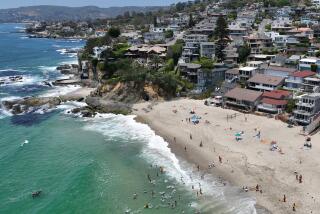Number of beach closures due to pollution rose last year, report says
The number of times the nation’s beaches were closed or posted with warnings because of polluted water jumped last year to its second-highest level in 21 years, in part because of the Gulf of Mexico oil spill and heavy rains that swept pollutants into the ocean at an accelerated rate, according to a report released Wednesday.
The Natural Resources Defense Council found that contamination from oil, urban runoff, and human and animal waste continued to take a toll on beaches across the country in 2010, according to the report.
In California, where heavier than normal rainfall greatly increased the amount of water and pollutants being flushed into the ocean, closures and advisories nearly doubled, and the number of beach water tests that exceeded state health standards rose to 11% from 9% the year before.
On the Gulf Coast, oil washed up on about 1,000 miles of shoreline. Since the spill, there have been so many oil-related closures, notices and advisories at beaches throughout the region that adding them all up totals 9,474 days, the report calculated.
The study, which showed a 29% increase in advisories or closures over the previous year, indicates that “the problems that we have in this country with beach water contamination in general are not getting better,” said Noah Garrison, an attorney for the environmental advocacy group.
Because storm runoff is a top source of beach water pollution, closures closely mirror precipitation patterns. When it rains, viruses, bacteria, fertilizers, toxic metals, trash and other pollutants are swept into the ocean and warnings to keep out of the water are often posted. When the weather is dry, the beaches tend to be cleaner and stay open.
The report surveyed bacteria test results at more than 3,000 beaches in 30 coastal and Great Lakes states. A high bacteria count means the beach water is likely to harbor pathogens that can sicken swimmers — causing skin rashes and stomach and respiratory illnesses, as well as other infections.
The results highlight the need to halt urban runoff so that water quality doesn’t wax and wane with the amount of rainfall, the group says.
“Hoping that it isn’t going to rain is not a viable storm water management strategy,” Garrison said.
There’s an urgent need, Garrison said, to treat urban runoff before it is swept into the ocean. He suggested a key is investing in an improved “green infrastructure” that captures, diverts or treats storm water or lets it filter back into the ground to keep pollutants from washing into the ocean.
The states with the most polluted beaches in 2010 were Louisiana, Ohio and Indiana, based on the percentage of times beaches failed to meet federal health standards. The cleanest beaches could be found in New Hampshire, New Jersey, Oregon, Hawaii and Delaware.
California fell near the bottom, ranking 22nd out of 30 states.
Three Southern California beaches made the report’s list of Top 10 “Repeat Offender” beaches with chronic pollution problems: Avalon Beach on Catalina Island, Cabrillo Beach in San Pedro and Doheny State Beach in Dana Point.
More to Read
Sign up for Essential California
The most important California stories and recommendations in your inbox every morning.
You may occasionally receive promotional content from the Los Angeles Times.











